Quick access to articles on this page:
more on the next page...
As I talked about in a previous blogpost, Keccak and SHA3-3 are different in their bit convention, which gave birth to quite an overly complicated specification. The lack of good explanations in both the reference implementations and the reference documents led me to write this blogpost.
Padding
Before going further, let me briefly re-explain the multi-rate padding also called pad10*1:
- take the input and append the delimiter (
01 for SHA-3)
- append a
1 to start the padding
- append enough
0s followed by a final 1 so that the resulting output is a multiple of the rate
Here is a graphical example with input 0x9c = 1001 1100 and where the rate of our permutation is only 3 bytes:
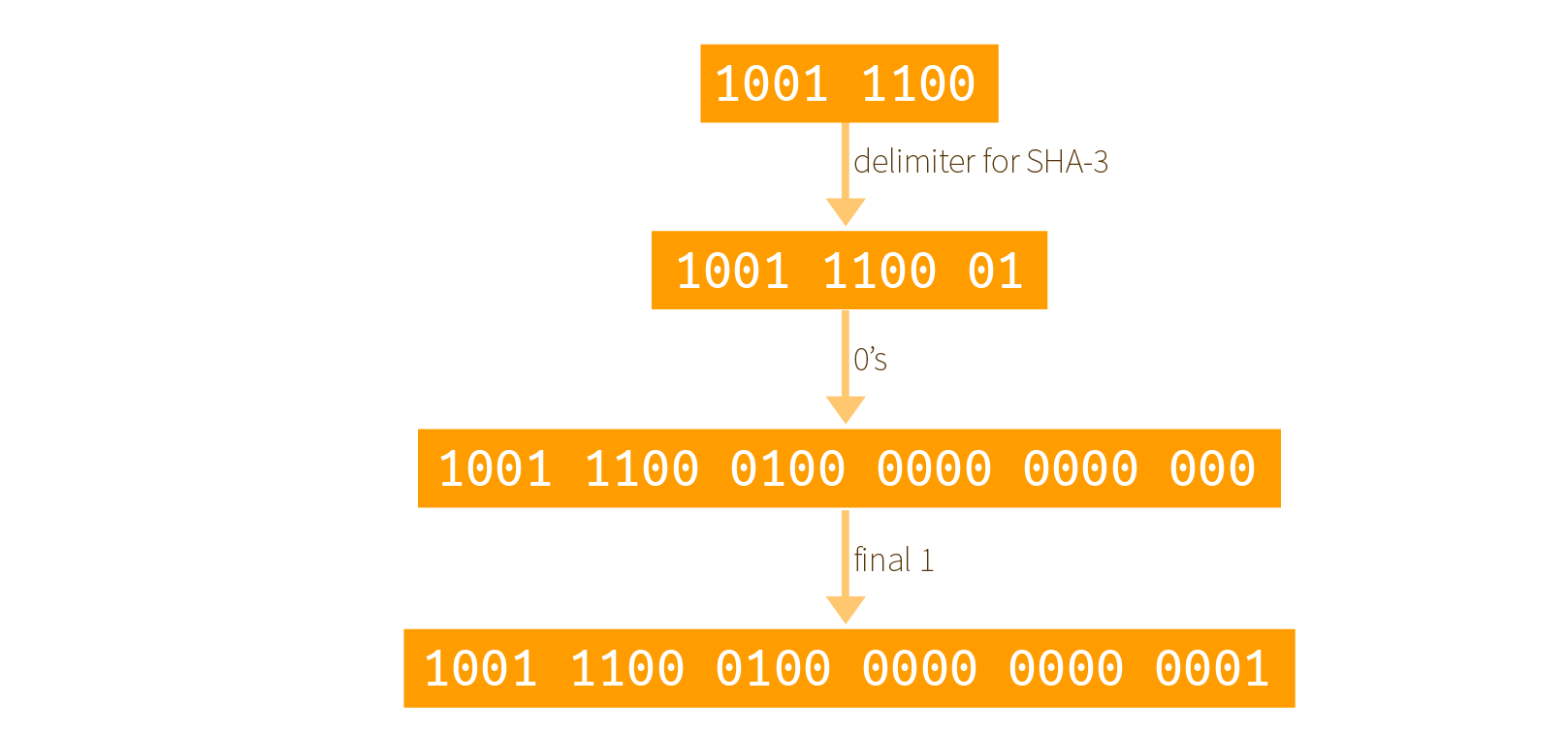
note that I forgot to add a 1 after the delimiter and before all the 0s (thanks Rachel)
Now, I'll just acknowledge that most implementations, and even the specification, talk about using 0x80 for the final bit. This blogpost should answer why.
Theoretical bit numbering
Keccak is specified in term of bits, but is discreetly aware of byte arrays as well. This is important as the rounds of Keccak require us to XOR parts of the input with lanes of the state. These lanes can be represented as uint64 types for keccak-f[1600], which we'll be looking at in this blogpost.
It could be hard to understand what is really going on in FIPS 202, but a look at an older version of the specification shows that Keccak interprets byte arrays in big-endian, but with an LSB bit numbering.
If you look at the Appendix B.1 of FIPS 202. You can see that before an input can be interpreted by SHA-3, it needs to go through some transformations.
Here is our own example of how it works with an input of 0xaebcdf. First the bits are re-mapped, then a padding is added, finally it is split into as many lanes as possible (here we have two 16-bit lanes):

The same examples with bits:
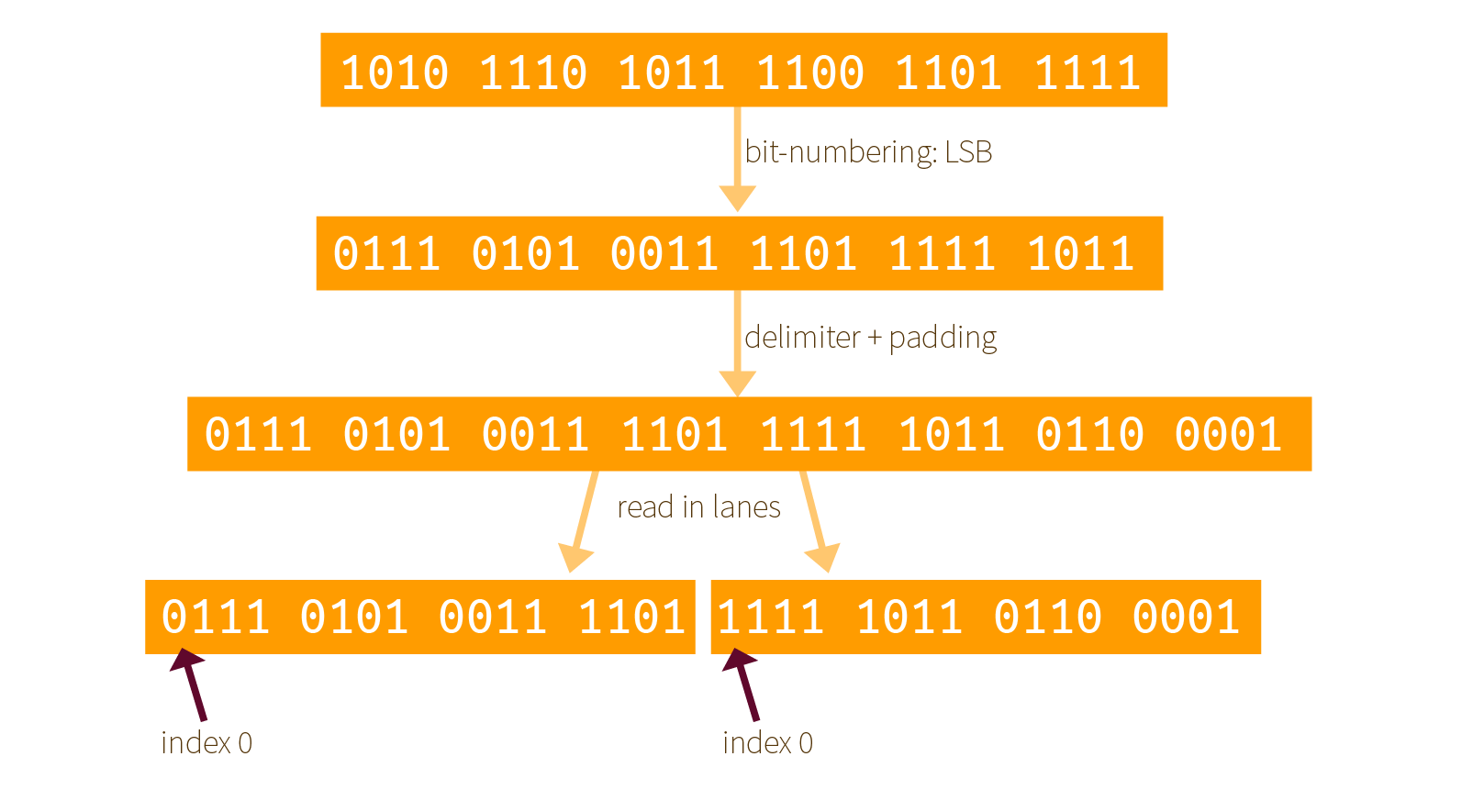
Two things that you must understand here:
- the padding is applied after re-mapping the bits, not before! Since the padding is already defined for Keccak's internal ordering of its bits.
- all of this is done so that a bit string is indexed as LSB first, not MSB first. It's weird but Keccak did it this way.
Why is the indexing of a bitstring so important?
Because we later apply the permutation function on the state, and some of the operations need to know what are the indexes of each bits. More on that later.
How to implement the re-mapping
It must be annoying to reverse all these bits right? What about not doing it? Well brace yourself, there is indeed a clever trick that would allow you to avoid doing this. And this trick is what is used in most of SHA-3's implementations. Here is a graphical explanation of what they do:

By reading the byte array as little-endian, and using an already reversed delimiter + padding, some magic happens!
The result is exactly the same but in reverse order.
If you aren't convinced look at the following diagram (which shows the same thing with bits) and look at the previous section result. Same, but the bitstream is readable in the reversed direction.
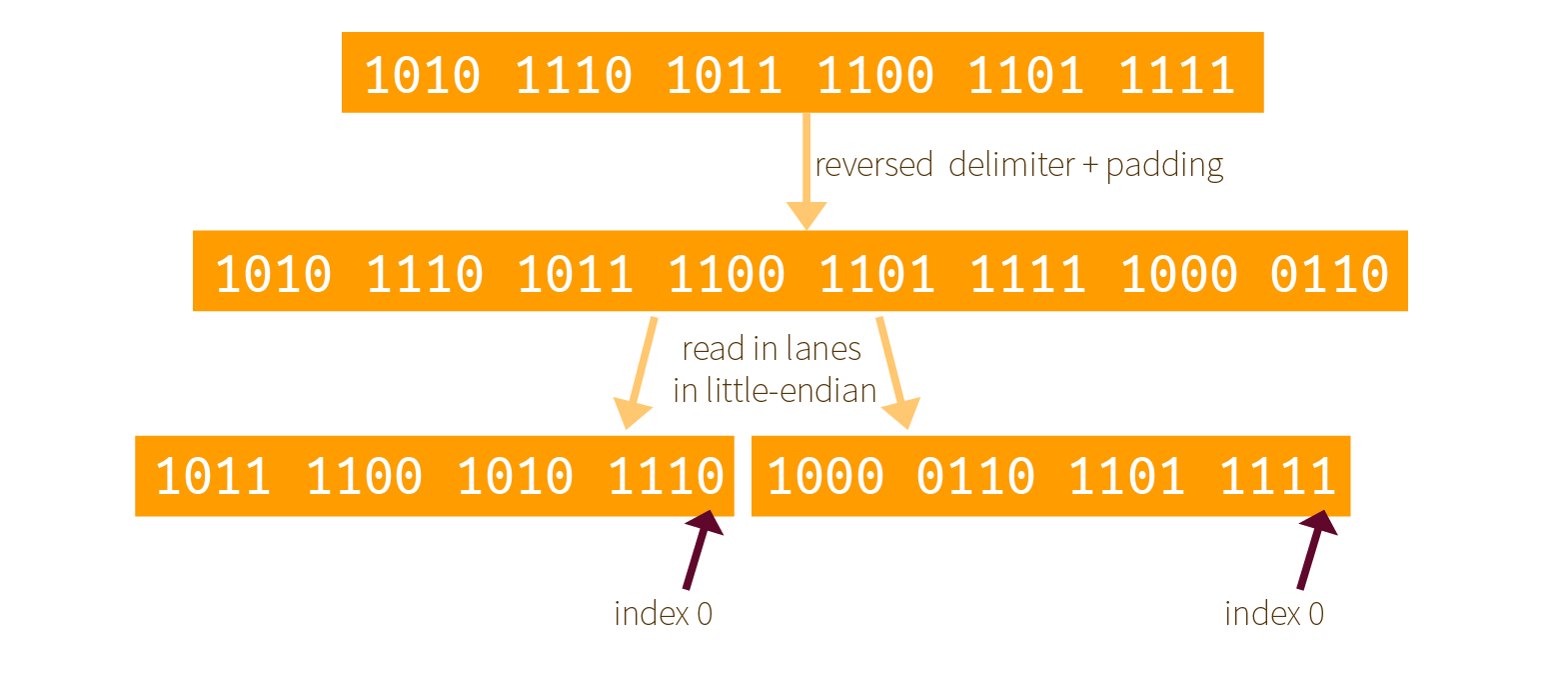
This means that now the index 0 of Keccak's internal ordering is on the right, not on the left. How will it influence the round functions that apply on our lanes?
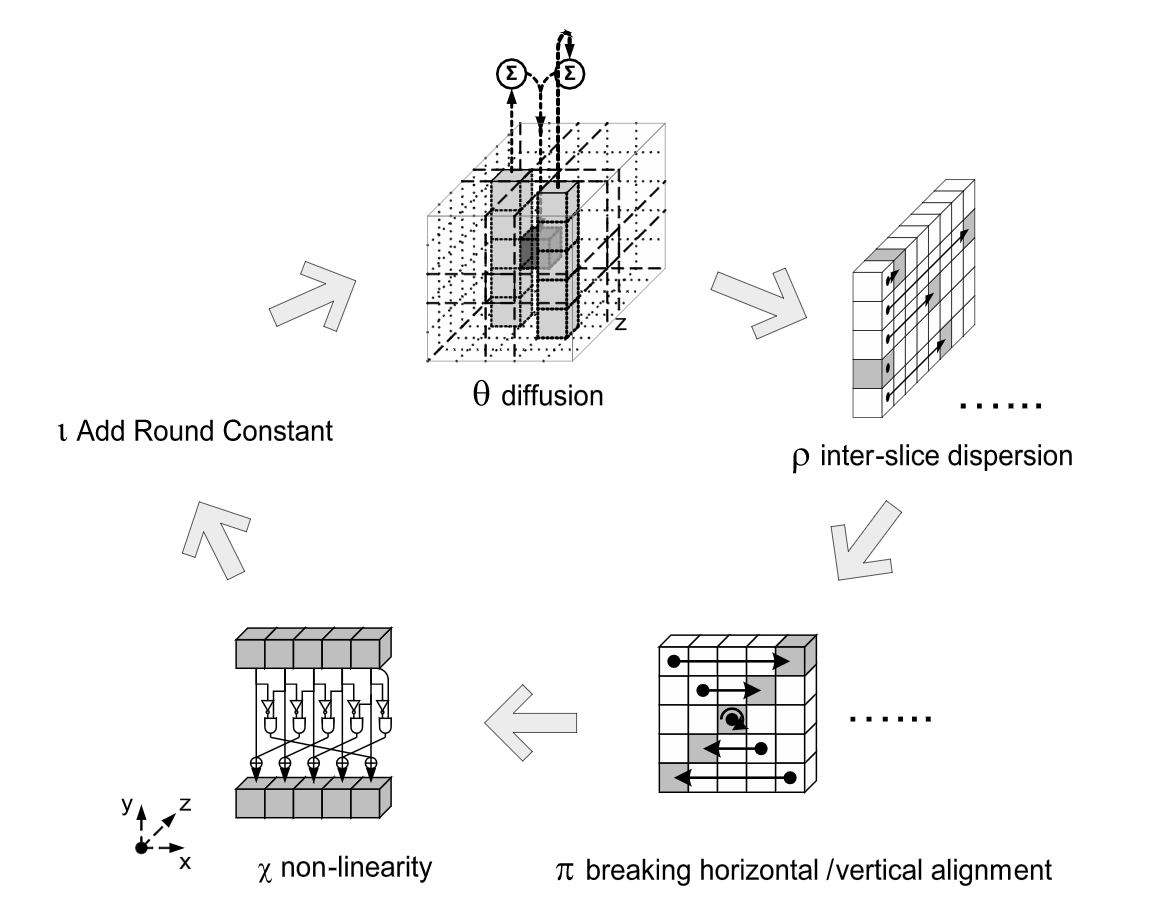
It turns out that a lot of operations are unchanged. Who would have known that XORs, ANDs and NOTs operations were not affected by the order of the bits! but only some rotations and bit positioning are. If you look at the reference implementations you will see that indeed, rotations have been reversed (compared to what the reference tells you to do).
And this is how a clever implementation trick made its way in a specification with no real explanation.
You're welcome!
"Why is Java a big pile of crap?" said the article. And after reading through the argumentation, I would move to the comment section and read a divergent point of view. Who was right? I wondered. Although everyone knows that Java is indeed a huge pile of crap, many other articles follow the same path of disputing one biased opinion that might be right, wrong, but really is both. I often mused on if I would come to write such a piece, and I think today is the day.
Keccak's (and/or SHA-3's) specification makes no sense.
Yup, it makes no sense, and I have a list of points you'll have to read through to understand how exactly.
By the way, if you didn't know, Keccak was the winner of the SHA-3 competition and blablabla...

Chocoweird indexing
First, let me introduce you to the internal state of Keccak.
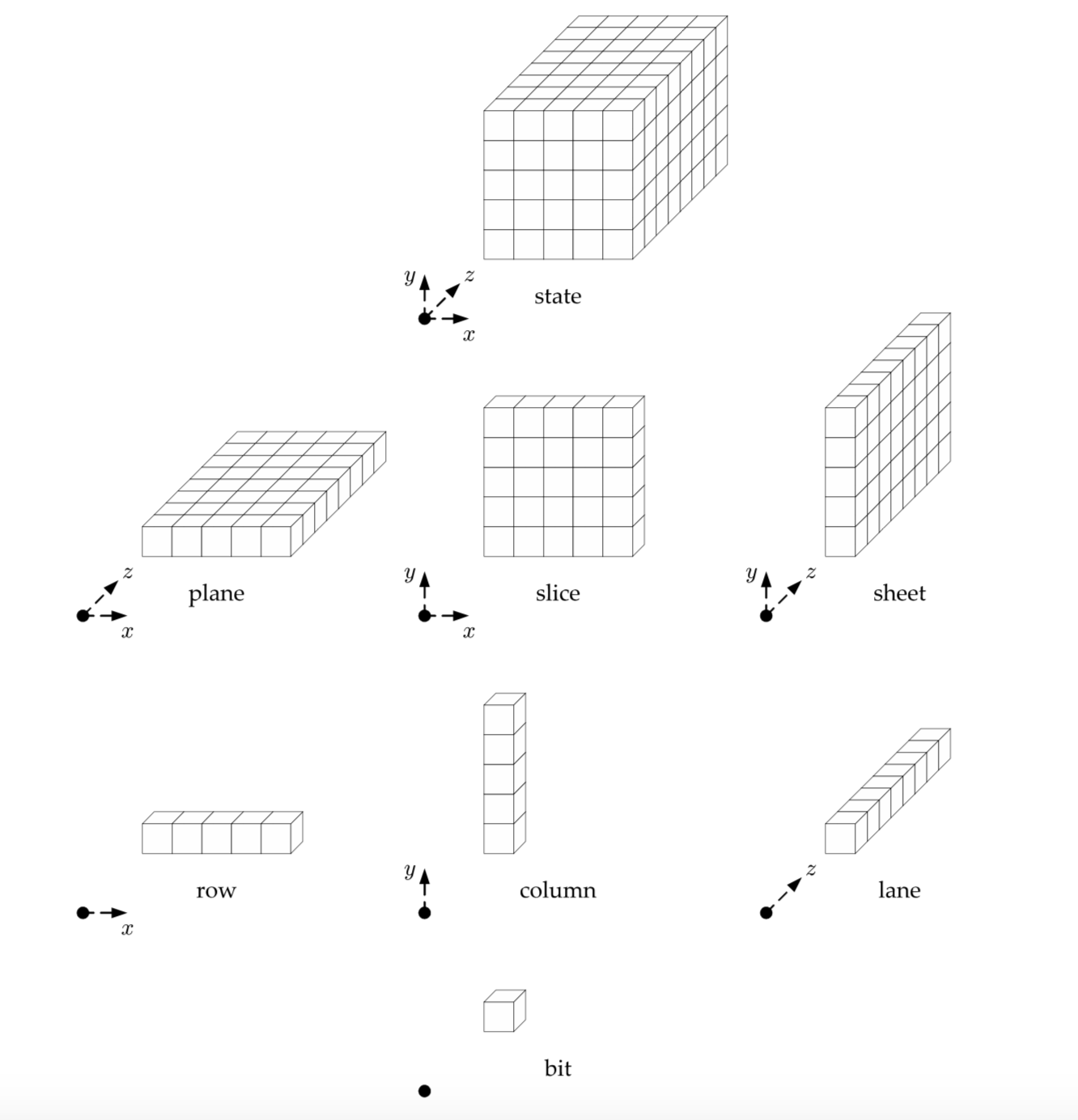
It is some sort of rectangular 3D object, and its different sub-objects have different names. Each little cube is a bit (a 1 or a 0). Cute.
I mean why not, AES was a square right? If we make it 3D we augment the security by one dimension. Sounds logical.
It gets weirder.
This is how the little cubes are indexed.
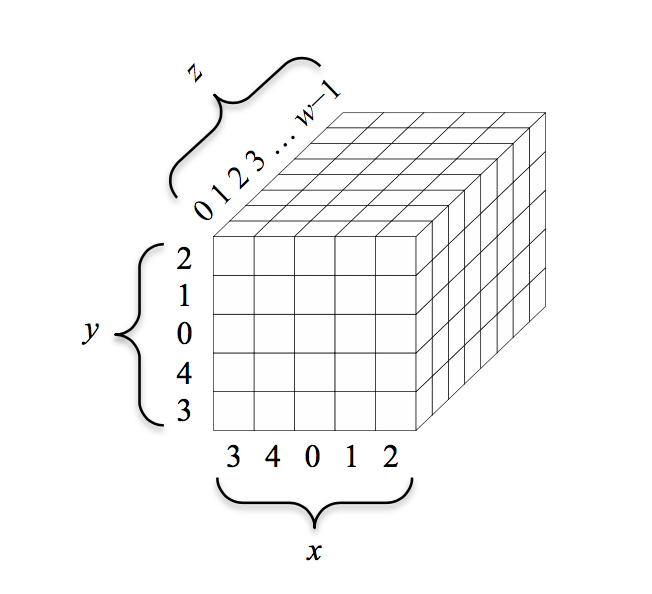
If you've started to reason on how you could translate that thing into a struct, stop. Don't overthink it. The x and y coordinates don't matter: all operations are done modulo the other columns or rows or you name it... you could have the indexes x = 0 and y = 0 anywhere really; it wouldn't change a thing. This picture doesn't even appear in Keccak's specification, only in FIPS 202. It is probably a joke from the NIST.
Multiple of bytes? Nopecheese
A uint8_t array
...you must have thought, still trying to have a head start, still shooting to figure out how you would stuck these bits in your code.
But wait. The NIST loves to think about bits though, not bytes. That's often surprising to people who end up implementing their specs with a byte length instead of a bit length and it led to what DJB calls a bit attack.
SHA-3 was no exception, NIST said to Keccak: you shall be able to handle the darkest desires of our stupid developers. You must account for ALL INPUTS. You must accept non-multiple of bytes.
Keccak provided. You can now hash 7-bit inputs with SHA-3.
The poor user is given enough rope with which to hang himself -- something a standard should not do.
—Rivest, 1992, commenting on the NIST/NSA “DSA” proposal
Bit indexing brainfudge
Let's talk about bit numbering, not byte order like big-endian and little-endian, no-no, bit numbering.
There are two ways to order bits in a byte (and we'll say here that a byte is an octet: it contains 8 bits):
- MSB first:
0x02 = 0000 0010, 0x01 = 0000 0001, ...
- LSB first:
0x40 = 0000 0010, 0x80 = 0000 0001, ...
Now what does this have to do with Keccak?
Keccak's bit numbering is LSB first, whereas NIST's one is MSB first (no kidding).
This means a re-mapping needs to take place when converting an input to the internal state of Keccak. This was all explained in the old specification of Keccak (see section 5).
Unfortunately these explanations disappeared in the latest version of the spec, and the NIST ended up writing up the conversion in an appendix (B.1) of their own specification FIPS 202.
Let me tell you: FIPS 202's explanation makes no sense. They end up mixing the theoretical internal state of Keccak with methods on how you can implement the re-mapping without having to inverse the bits of each bytes. It took me a while to figure it out and I am not the only one (most questions about Keccak/SHA-3 on internet end up being about their bit re-ordering).
Conclusion
Is SHA-3 Complicated? Some people would say no. But in reality there is no way to understand how to implement SHA-3 without looking at a reference implementation. NIST standards should seriously take a look at the process of TLS 1.3: no-one has been seen copying a reference implementation. Implementers are independently coding up what they understand of the draft specifications, and if cross-testing doesn't work it's either because they failed to understand something or because the specification needs some more love.
Having said that, Keccak is really cool and some of its applications look promising.
If you look at Go's implementation of GCM, in particular this, you can see that the counter is set to nonce||1:
if len(nonce) == gcmStandardNonceSize {
// Init counter to nonce||1
copy(counter[:], nonce)
counter[gcmBlockSize-1] = 1
}
It needs to be. Without it, the first block of keystream is the encryption of 0 if the nonce is 0 (which can happen if nonces are generated from a counter). The encryption of 0 is also... the authentication key!
Draft 19 has been published, this is a quick post talking about what has changed. This is mosty taken from the draft changelog as well as reading the commits since version 18. I've tried to keep up with what was important, but I ignored the many typos and small fixes, as well as what I think doesn't matter from draft to draft (exporters, cookies, ...)
Add pre-extract Derive-Secret stages to key schedule
The key schedule part of TLS 1.3 is quite tricky. At different stage of the connection a "secret" is derived from different inputs, and used again to derive different keys and IVs (to encrypt/decrypt data). When a new phase begins (for example when handshake messages need to be encrypted, or when the handshake is over and application data messages need to be encrypted) a new secret is derived and new keys can be derived from that secret.

Here you can see (the top arrow) that the Handshake secret is derived using the HKDF-Extract() function with the previous secret and the Diffie-Hellman key exchange output. Keys and IVs for both the Client and the Server are then derived from that secret (arrows pointing to the right). Next (all the way down) the Master secret is derived from that secret and the traffic keys, protecting the application data, can be derived from it.
Notice the Derive-Secret() function being used before re-using HKDF-Extract() again. This is new in Draft 19. This Derive-Secret() is the HKDF-Expand() function. If you know HKDF you know that it acts like a lot of different KDFs: in two steps. It extract the entropy given, and it then expands it. This was used to derive keys (you can see it with the arrows pointing on the right), but not to derive secrets. It is now fixed and that's why you can see it being used to derive the new Master secret. One of the positive outcome of this change is that HKDF can now more easily be replaced with another KDF.
Consolidate "ticket_early_data_info" and "early_data" into a single extension
This was an easy one.
The early_data extension was an empty extension used by a Client in the ClientHello message when it wanted to send 0-RTT data; and by a Server in the EncryptedExtensions message to confirm acceptance of the 0-RTT data.
The ticket_early_data_info was an extension that a Server would send in a ticket (for session resumption) to advertise to the Client that 0-RTT was available. It only contained one field: the maximum size of the data that should be sent as 0-RTT data.
Both are now merged under early_data which can be used for both purposes. Less extensions :) it's a good thing.
struct {} Empty;
struct {
select (Handshake.msg_type) {
case new_session_ticket: uint32 max_early_data_size;
case client_hello: Empty;
case encrypted_extensions: Empty;
};
} EarlyDataIndication;
Change end_of_early_data to be a handshake message
To use the 0-RTT feature of TLS 1.3, a client can start sending 0-RTT data right after a ClientHello message. It is encrypted with a set of keys and IVs derived from the PSK and the ClientHello. The PSK will typically be some resumption secret from a previous connection, but it can also be a pre-shared key (yeah, you can't do 0-RTT if you don't already share some secret with the server). The image below is taken from the key schedule section.
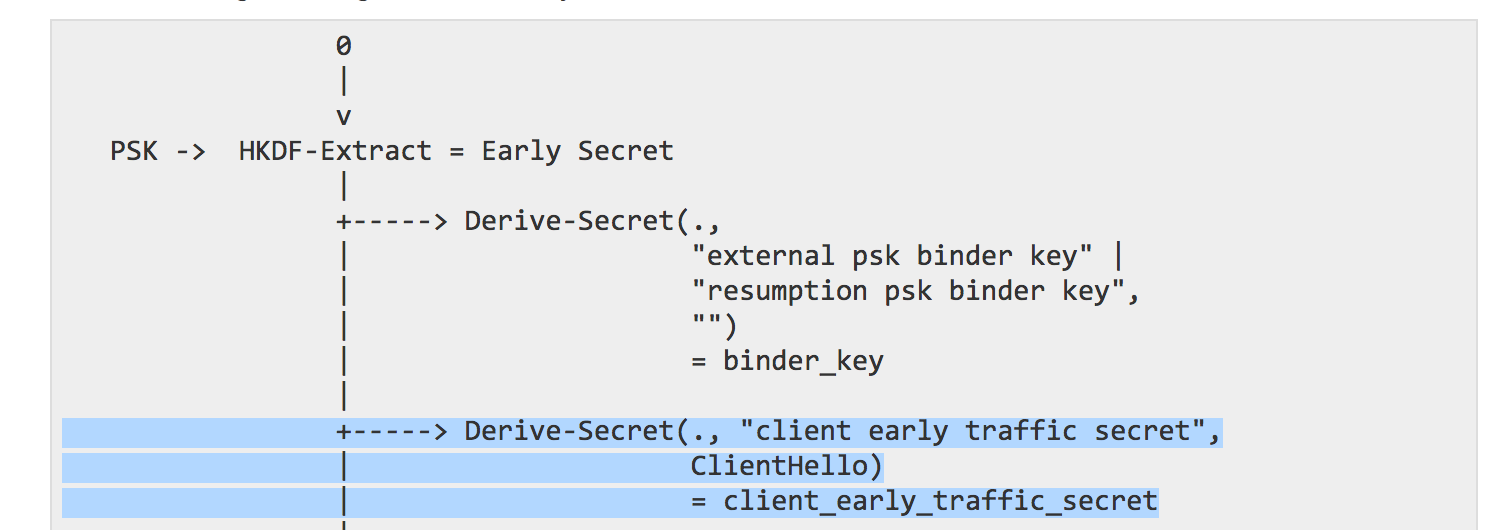
When a client is done sending this 0-RTT data, it can then finish the handshake by sending the remaining handshake messages (Certificate, CertificateVerify, Finished). These remaining handshake messages are encrypted (new in TLS 1.3) under a handshake key. To warn the server that the client is done sending 0-RTT data and that it is now using the handshake key to encrypt messages, it would previously (draft 18) send a end_of_early_data alert. This alert is now a handshake message! Which is what it should have been all along :)
Add state machine diagram
New diagrams representing the different client/server state machines made their way in draft 19! TLS 1.3 will officially be the first TLS RFC to provide so many diagrams. And they're beautiful too, what an artistic performance.
server workflow
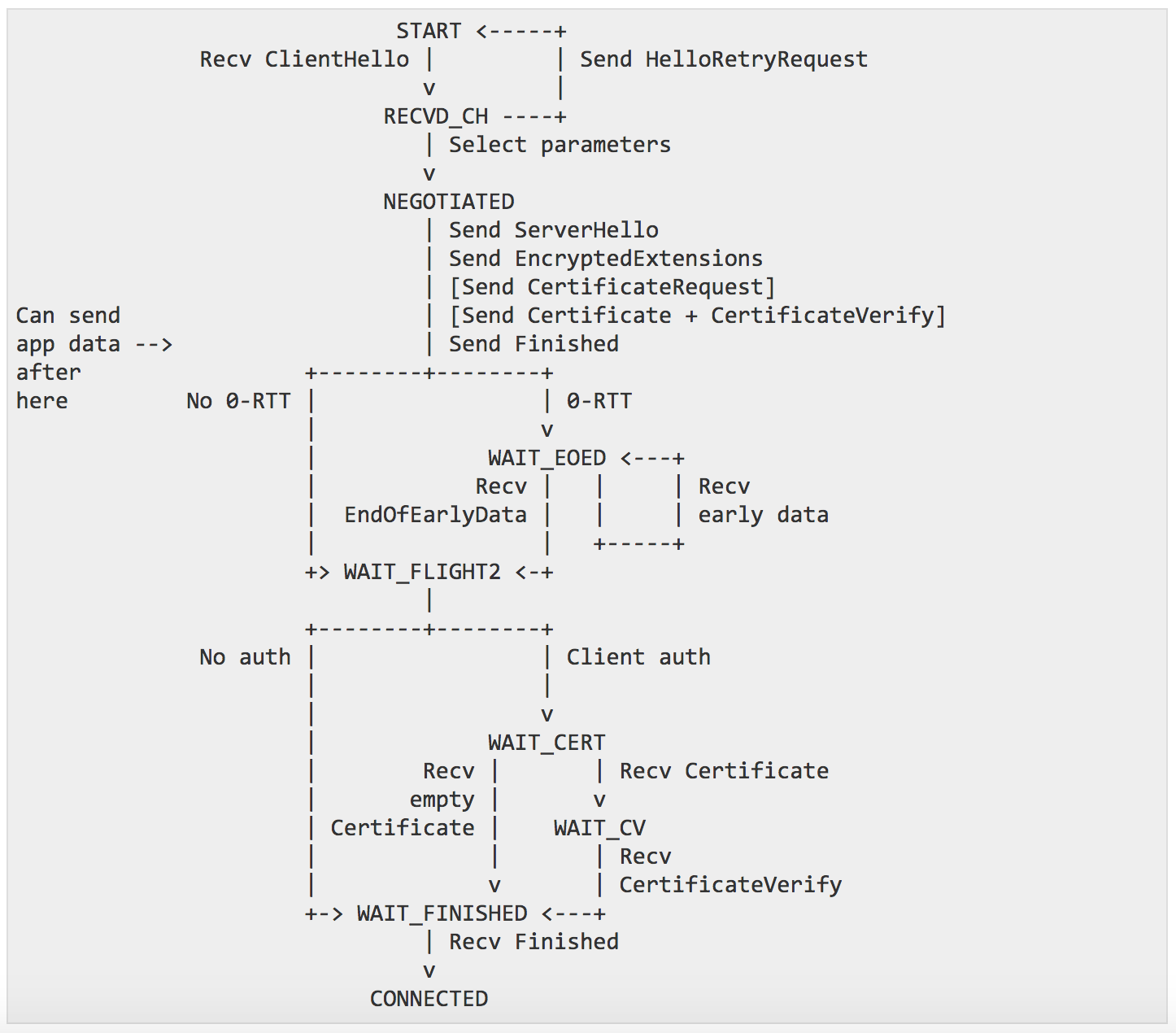
client workflow
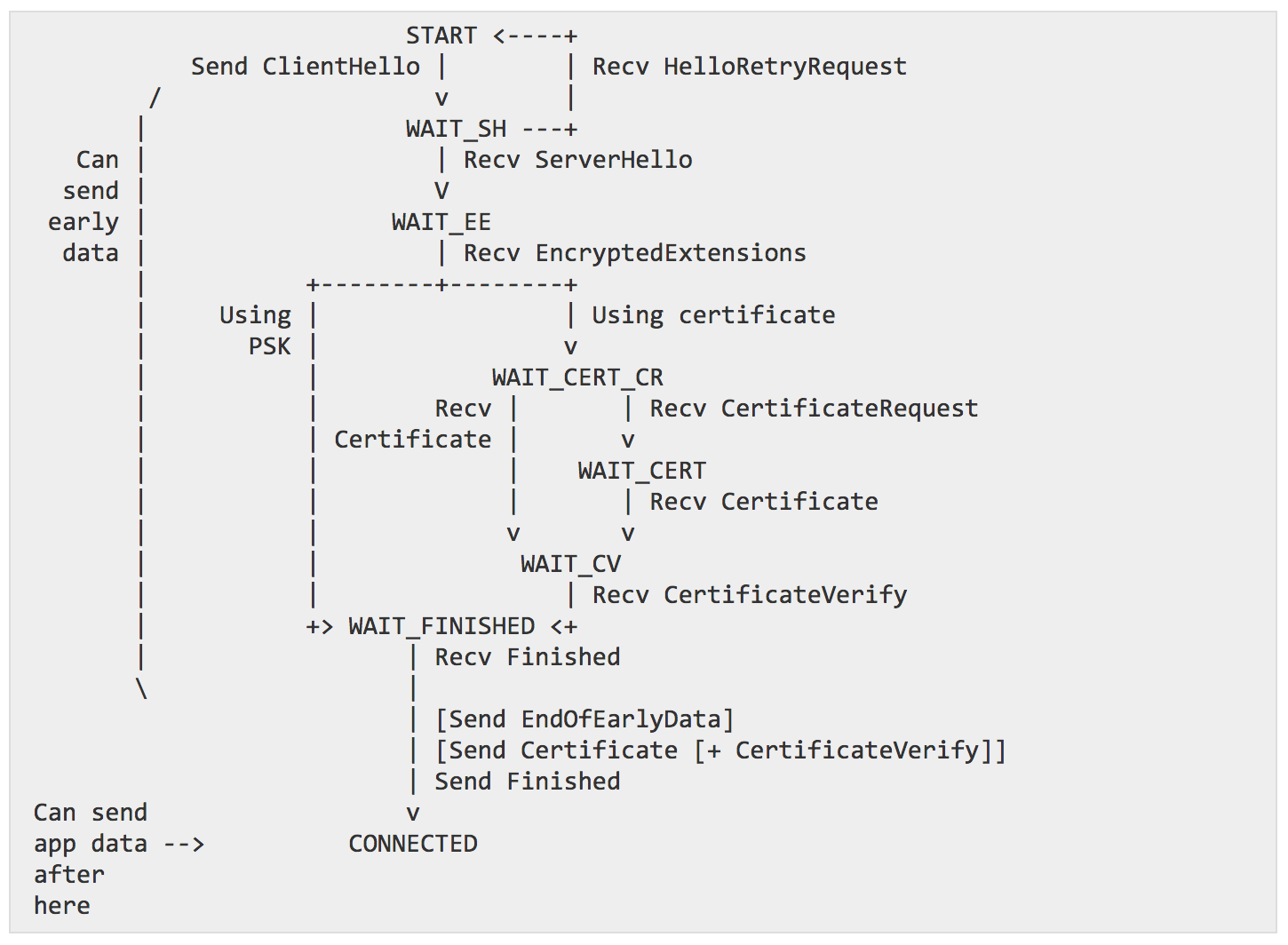
That's about it
I haven't spotted anything else major. Some SHOULDs became MUSTs, and some MUSTs became SHOULDs. At the moment, I believe the PSK and 0-RTT flows are quite hard to understand. Perhaps a diagram representing the flow of PSK from a server or client would be nice to have. Eric Rescorla has pointed out a few questions that should be answered to move the draft forward. I've seen so many issues, PR and commits these last weeks that I'm wondering when TLS 1.3 will be considered ready... but it's moving forward :)
After Real World Crypto, like every year, NCC Con follows next.
NCC Con is the NCC Group conference, a conference for its employees only, with a bunch of talks and drinks. I gave a talk on TLS 1.3 that I hope I can translate to a blog post at some point.
This year I also designed the NCC Group's Mascot! Which was given away as a T-shirt and a sticker to all the employees at the conference. It was a pretty surreal moment for me to see people around me, at the conference and in the casinos (it was in Vegas) wearing that shirt I designed :D


And here is a wallpaper with my original submission
Some pictures with people wearing it :)

(The notes for day 2 are here.)
The first talk on Quantum Computers was really interesting, but unfortunately mostly went over my head. Although I'm glad we had a pro who could come and talk to us on the subject. The take away I took from it was to go read the SMBC comics on the same subject.
After that there was a talk about TPMs and DAA for Direct Anonymous Attestation. I should probably read the wikipedia page because I have no idea what that was about.
Helena Handschuh from Cryptography Research talked about DPA Resistance for Real People. There are many techniques we use as DPA countermeasures but it seems like we still don't have the secret sauce to completely prevent that kind of issues, so what we really end up doing is rotating the keys every 3 encryption/decryption operations or so... That's what they do at Rambus, and at least what I've heard other people doing when I was at CHES this year. Mike Hamburg describes the way they rotate keys in his STROBE project a bit. Handschuh also talked about the two ways to certify a DPA-resistant product. There are evaluations like Common Criteria, which is usually the normal route, but now there is also validation. Don't ask me about that.
David Cash then entered the stage and delivered what I believe was the best talk of the conference. He started with a great explanation of ORE vs OPE. OPE (Order Preserving Encryption) allows you to encrypt data in a way that ciphertexts conserve the same lexicographic order, ORE (Order Revealing Encryption) does not, but some function over the ciphertexts end up revealing the order of the plaintexts. So they're kind of the same in the end and the distiction doesn't seem to really matter for his attacks. What matters is the distinction between Ideal ORE and normal ORE (and the obviously, the latter is what is used in the real world).
Ideal ORE only reveals the order while the ORE schemes we use also reveal other things, for example the MSDB (most significant different bits) which is the position of the first non-similar bit between two plaintexts.
Previous research focused on attacking a single column of encrypted data while their new research attacks columns of correlated data. David gives the example of coordinates and shows several illustrations of his attack revealing an encrypted image of the linux penguin, encrypted locations on a map or his go-about saved and encrypted by a GPS. Just by looking at the order of coordinates everything can be visually somewhat restored.
Just by analyzing the MSDB property, a bunch of bits from the plaintexts can be restored as well. It seemed like very bad news for the ORE schemes analyzed.
Finally, two points that seemed really important in this race for the perfect ORE scheme is that first: the security proofs of these constructions are considering any database data as uniformly random, whereas we know that we rarely need to store completely random data :) Especially columns are often correlated with one another.
Second, even an (hypothetical) ideal ORE was vulnerable to their research and to previous research (he gave the example of encrypting the whole domain in which case the order would just reveal the plaintexts).
This is a pretty bad stab at ORE scheme in general, showing that it is intuitively limited.
Paul Grubbs followed with an explanation of BoPETS, a term that I believe he recently coined, meaning "Building on Property revealing EncrypTion". He gave a good list of products that I replicated below in a table.
| Order Preserving Encryption |
SAP, Cipherbase, skyhigh, CipherCloud, CryptDB |
| Searchable Encryption |
Shadowcrypt, Mylar, kryptonostik, gitzero, ZeroDB, CryptDB |
| Deterministic Encryption |
Perspecsys, skyhigh, CipherCloud, CryptDB |
They looked at Mylar and saw if they could break it from 3 different attacker setups: a snapshot setup (smash and grab attack), passive (attacker got in, and is now observing what is happening), active (attacker can do pretty much anything I believe).
Mylar uses some encrypted data blob/structure in addition to a "principal graph" containing some metadata, ACL, etc... related to the encrypted data. Grubbs showed how he could recover most of the plaintexts from all the different setups.
Tal Malkin interjected that these attacks would probably not apply to some different PPE systems like IBM OXT. Grubbs said it did not matter. Who's right, I don't know.
As for the active attacker problem, there seem to exist no intuitive solution there. If the attacker can do anything, you're probably screwed.
Raluca Ada Popa (Mylar) followed Grubbs by talking about her product Mylar and rejected all of Grubbs claims, saying that there were out of the scope of Mylar OR were attacking mis-use of the product. IIRC the same thing happened when CryptDB was "broken", CryptDB released a paper arguing that these were false claims.
After Mylar, Popa intend to release two new products with better security: Verena and Opaque.
David Mcgrew mentionned Joy and gave a long talk about detecting PRNG failures. Basically look for public values affected by a PRNG like signatures or the server/client random in TLS.
And that was it. See you next year.
If you have anything to say about my notes, the talks, or other people's notes, please do so in the comments :)
There was a HACS workshop right after RWC, and Tim Taubert wrote some notes on it here.
Here we go again. Some really short notes as well for today. (The notes for day 1 are here.)
Trevor Perrin talked about Message Encryption from an historical point of view, from key directories to public key infrastructures and how to authenticate users to each other. Something interesting that Trevor talked about was CONIKS, some sort of Certificate Transparency-like protocol but for secure messaging (they call it key transparency).
when Alice wants to send a secure message to some other user, say Bob, her CONIKS client looks up Bob's key at the key directory, and verifies that this key has not changed unexpectedly over time. It also checks that this key is consistent with the key other clients are seeing for Bob. Only if these two consistency checks pass will the CONIKS client send Alice's message to Bob. The CONIKS client also performs these same checks for Alice's own key on a regular basis to ensure that the service provider is not tampering with Alice's key.
This sounds like an audit system (users can check what a key distribution server has been up to) + a gossip protocol (users can talk between them to verify consistency of the obtained public keys). Which seems like an excellent idea and makes me wonder why would Signal not use it.
djb mentioned the Self-Healing feature of ZRTP, similar to the recovery feature of Signal.
ZRTP caches symmetric key material used to compute secret session keys, and these values change with each session. If someone steals your ZRTP shared secret cache, they only get one chance to mount a MiTM attack, in the very next session. If they miss that chance, the retained shared secret is refreshed with a new value, and the window of vulnerability heals itself, which means they are locked out of any future opportunities to mount a MiTM attack. This gives ZRTP a "self-healing" feature if any cached key material is compromised.
Signal's self-healing property comes from the fact that an ephemeral Diffie-Hellman key agreement is continuously happening during communication. Like ZRTP it seems like it works out well only if the attacker is slow to act, thus it doesn't seem to be exactly comparable to backward secrecy (which might just be impossible in a protocol).
Later, someone (I don't know who from Felix Günther, Britta Hale, Tibor Jager and Sebastian Lauer because the program doesn't specify who the speaker is), presented on a 0-RTT system that would provide forward secrecy and anti-replayability. 0-RTT is one of the feature of TLS 1.3, which allows a client to start sending encrypted data to a server during its very first flight of messages. Unfortunately, and this was the topic of many discussions on TLS 1.3, these messages are replayable.
The work builds on top of Math Green's work with Puncturable Encryption where the server (and the client?) use some key derivation system and remove parts of it after a message has been sent using the 0-RTT feature. I am not sure if this system is really efficient though, especially since the point of 0-RTT is to be able to be fast. If this solution isn't faster or, worse, slower than doing a normal TLS 1.3 handshake (1.5 round trips) then the 0-RTT has no meaning in life anymore.
It also seems like this wouldn't be applicable to the "ticket" way of doing 0-RTT in TLS 1.3, which basically encrypts the whole state and hand up the opaque blob to the client, this way the server doesn't store anything.
Hugo Krawczyk (the HKDF guy) talked about passwords and leaks with some Comic Sans MS (and there was this handy website to check if your username/password/... had been compromised). Hugo then presented some of his recent work on SPHINX, PPSS, X-PAKE, ... everything is listed with link to papers here.
SPHINX is a client-focused and transparent-to-the-server password manager (like all of them really). The desktop password manager uses some derivation parameter stored online or on a user's mobile phone to derive any website key from a master password. The online service or the mobile phone never sees anything (thanks to a simple blinding technique, reminding me of what Ari Juel did last year's RWC with PASS). Because of that, no offline attack are possible. The slides are here and are pretty self explanatory. I have to admit that the design makes a lot of sense to me. I dozed off for the second part of the talk but it was about "How to store a secret" and his PPSS thing (Password Protected Secret Sharing), same for the third part of the talk that was about X-PAKE, which I can imagine was a mix of his ideas with the PAKE protocol.
There were two talks about memory-hardness and proving that password hashing functions are memory-hard. It seemed like some people think it's important that these functions be data-independent as well (probably because in some cases cache attacks might be an issue). Most of the techniques here seemed to make sure that a minimum amount of memory was to be used at all time, and that this couldn't be reduced. I would have liked to see a comparison between Argon2 (the winner of the PHC), Blake 2 (which seems to be the thing people like and use) and Balloon Hashing (which seems to be Dan Boneh's new thing).
George Tankersley and Filippo Valsorda finished the day with a talk on Cloudflare and their CAPTCHA problem. A lot of attacks/spam seems to come from TOR, which has deteriorated the reputation of the TOR nodes' IPs. This means that when Cloudflare sees some traffic coming from TOR, it will present the user with a CAPTCHA to make sure they are dealing with a human. TOR users tend to strongly dislike Cloudflare because these CAPTCHA are shown for every different website, and for every time the TOR path is changed (10 minutes?). This, in addition to TOR already slowing down your browsing efficiency, has annoyed more than one person. Cloudflare is trying to remediate the problem by giving not one, but N tokens to the user for one CAPTCHA solved. By using blind signatures Cloudflare hopes to demonstrate its inability to deanonymize users by using a CAPTCHA token as a tracking cookie.
(I have been made aware of this problem in the past and have manually added TOR visitors as an "allowed country" in my Cloudflare's setup for cryptologie.net., which is one of the solution given to Cloudflare's customers.)
I believe the drafted solution is readable here if you're interested.
Here are more resources:
The notes for day 3 are here.
Today was the first day of Real World Crypto. My favorite con (I think I've been saying that enough). I have avoided taking long notes about this one (as I did for the previous one). But fortunately a live stream was/is available here.
The Lechvin prize was given to Joan Daemen, co-inventor of AES and SHA3, and to Moxie Marlinspike and Trevor Perrin for their work on the development on secure messaging.
Daemen talked about how block cipher might become a thing from the past, replaced by more efficient and faster permutation constructions (like the permutation-baed sponge construction they developed for SHA3).
Moxie Marlinspike gave an brilliant speech. Putting that into words would only uglify whatever was said, you will have to take my words for it.
Rich Salz gave a touching talk about the sad history of OpenSSL.
Thai Duong presented his Project Wycheproof that test java cryptographic libraries for common cryptographic pitfalls. They have something like 80 test vectors (easy to export to test other languages) and have uncovered 40+ vulnerabilities. One is being commented here.
L Jean Camp gave a talk on some X.509 statistics across phishing websites and the biggest websites (according to some akamai ranking). No full ipv4 range stats. Obviously the phishing websites were not bothering with TLS. And the speaker upset several people by saying that phishing websites should not be able to obtain certificates for similar-looking domains. Adam Langley took the mic to explain to her how orthogonal these issues were, and dropped the mic with a "we will kill the green lock".
Quan Nguyen gave a nice talk about some fun crypto vulns. Unfortunately I was dozing off, but everyone seemed to have appreciated the talk and I will be checking these slides as soon as they come up. (Some "different" ways to retrieve the authentication key from AES-GCM)
Daniel Franke presented the NTS (Network Time Security) protocol. It looks like it could protect NTP. Is it a competitor of roughtime? On the roughtime page we can read:
The obvious answer to this problem is to authenticate NTP replies. Indeed, if you want to do this there‘s NTPv4 Autokey from six years ago and NTS, which is in development. A paper at USENIX Security this year detailed how to do it so that it’s stateless at the server and still mostly using fast, symmetric cryptography.
But that's what NTP should have been, 15 years ago—it just allows the network to be untrusted. We aim higher these days.
So I guess NTS is not coming fast enough, hence the creation of roughtime. I personally like how anyone can audit roughtime servers.
Tancrède Lepoint presented on CRYSTAL, a lattice-based key exchange that seems like a competitor to New Hope. He also talked about Open Quantum Safe that contains a library of post quantum primitives as well as a fork of OpenSSL making use of this library. Someone from the public appeared to be pretty angry not to be cited first in the research, but the session chair (Dan Boneh) smoothly saved us from an awkward Q/A.
Mike Hamburg came up with STROBE, a bespoke TLS-like protocol based on one sponge construction. It targets embedded devices but isn't really focusing on speed (?) It's also heavily influenced by BLINKER and tries to improve it. It kinda felt like a competitor of the Noise Protocol Framework but looking at the paper it seems more confusing than that and much more interesting as well. From the paper:
Strobe is a framework for building cryptographic two-party protocols. It can also be used for symmetric cryptosystems such as hashing, AEAD, MACs, PRFs and PRNGs. It is also useful as the symmetric part of a Schnorr-style signature scheme.
That's it. If anyone can point me to other notes on the talks I'd gladly post a list of links in here as well:
The notes for day 2 are here.

















